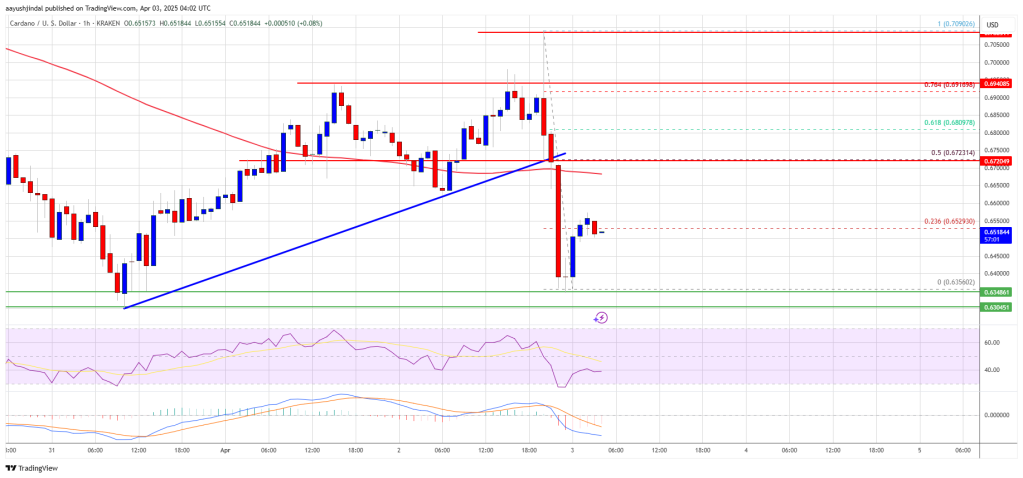Market
Why PEPE’s Swift Return to $0.000010 Could Be a Pipe Dream

The price of Pepe (PEPE), the Ethereum-based frog-themed meme coin, seems stable today. Like many other cryptos, PEPE has endured a long period of decline.
Currently, the token trades at $0.0000079, which is a 32% 30-day decrease. To erase these losses, the price has to return to $0.000010 at least. But can it?
Pepe Dormant Tokens Have Come Out of Their Shell
A 90-day increase in a meme coin’s Mean Coin Age (MCA) indicates that more previously dormant tokens are being moved back into circulation. MCA measures the average age of all tokens on a blockchain and provides insights into holder behavior.
Typically, when MCA decreases, it signals that investors are moving their assets out of long-term storage and into cold wallets, demonstrating faith in the coin’s long-term value.
However, an increase, like what’s happening with PEPE, suggests that long-held coins are being reintroduced into the market. This usually leads to heightened transaction activity and can be a precursor to sell-offs, as holders release tokens they previously held onto for a long time.
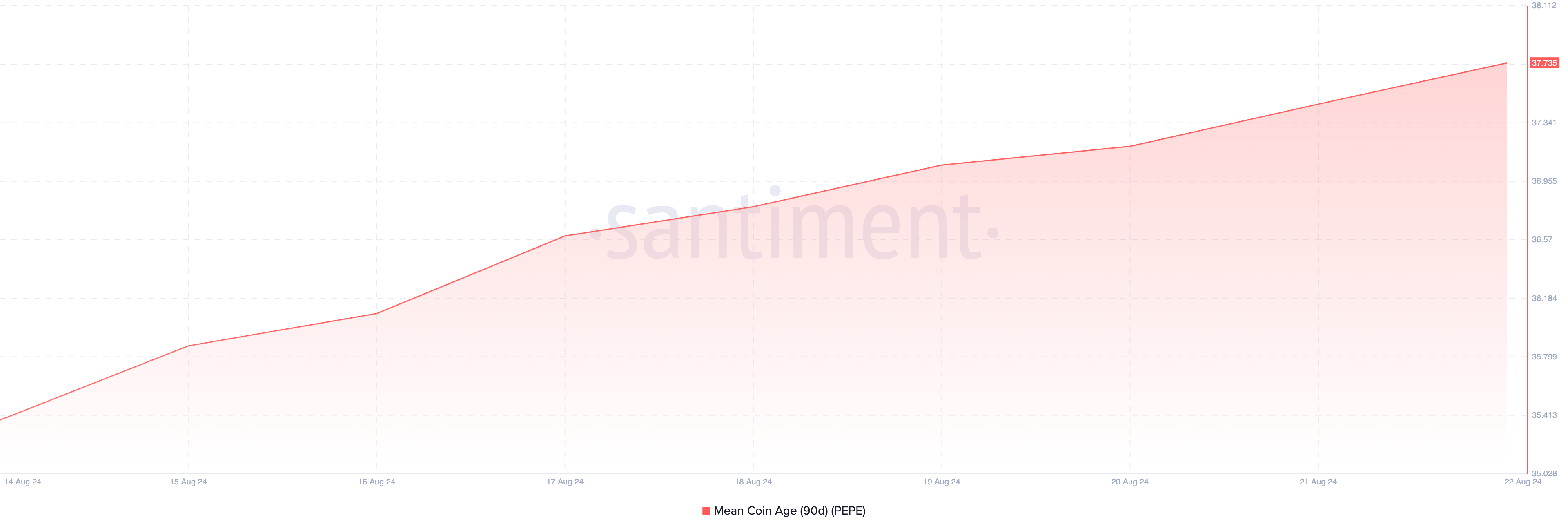
If the trend continues, the recent stability of the token could be at risk. On-chain data shows a decline in the number of addresses accumulating PEPE over the past 30 days, which is a concerning signal for short-term momentum.
Typically, a rise in short-term holders suggests increased demand, often leading to price growth as more traders accumulate positions. Conversely, a reduction in short-term holders usually points to weakening demand, which can result in either stagnant price action or a decline.
In PEPE’s case, if fewer short-term holders continue accumulating, this could either lead to prolonged sideways movement or further price drops, especially if dormant tokens continue to be unlocked and sold.
Read more: 5 Best Pepe (PEPE) Wallets for Beginners and Experienced Users
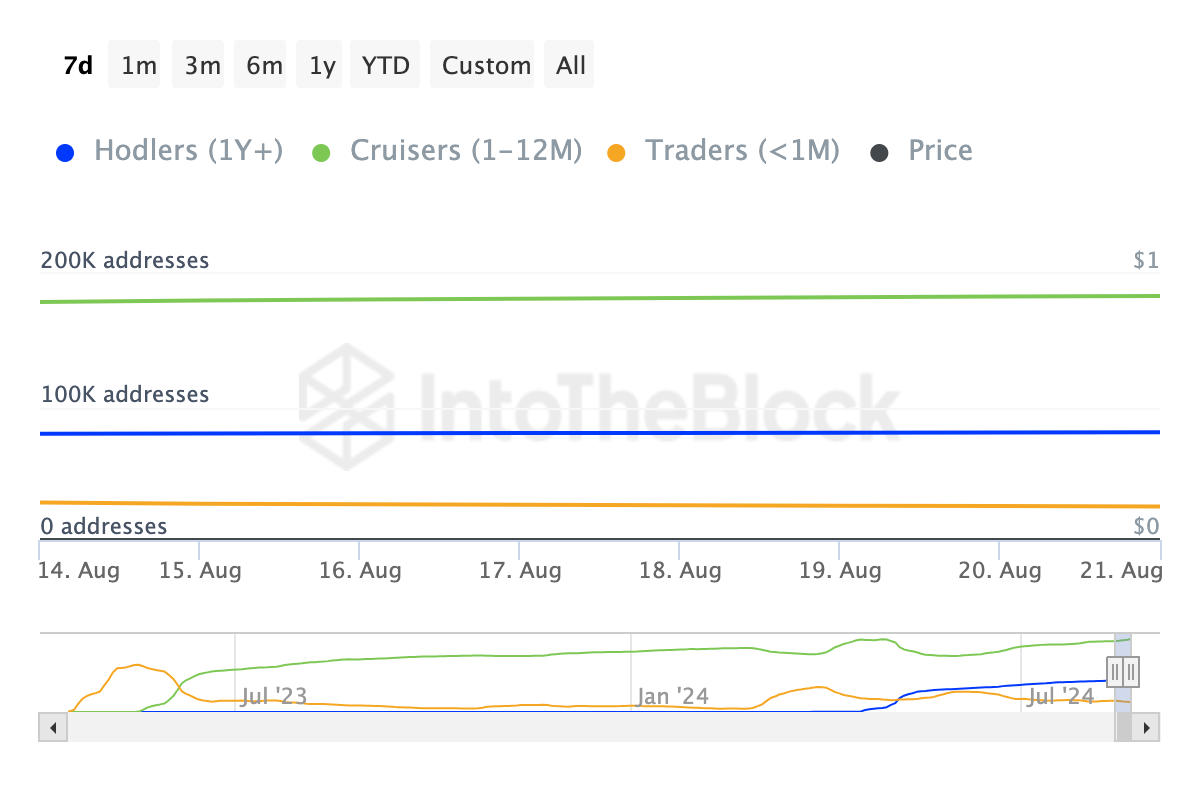
PEPE Price Prediction: The Bounce Could Be Hindered
From a technical standpoint, the lack of significant buying volume is one factor hindering a notable price jump for PEPE. On many occasions, the cryptocurrency experiences substantial respite when buyers accumulate in large volumes.
But over the past few weeks, and till the time of writing, this has not happened. Further, the Balance of Power (BoP) on the daily chart has turned downwards and is negative. The BoP is a price-based technical indicator that measures the strength of buyers and sellers in the market.
Positive values of the indicator suggest bullish dominance, while negative ones infer bearish control. As such, it appears that PEPE, despite its slight bounce, remains within reach of another rejection.
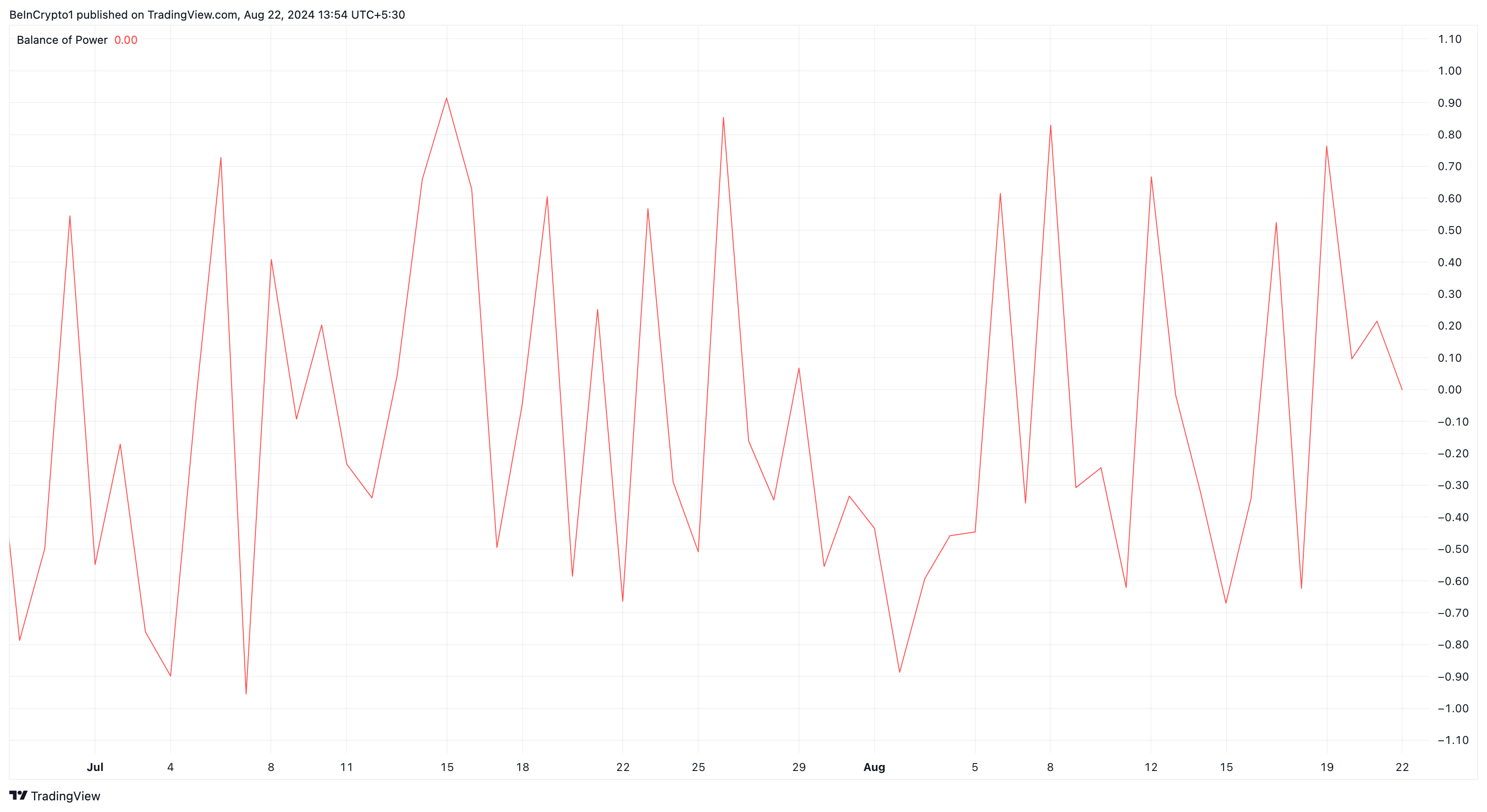
An assessment of the chart also reveals that the token trades below the demand zone between $0.0000085 and $0.0000088, suggesting that the recent upswing has yet to be validated. The token is also below the 20-day Exponential Moving Average (EMA).
The EMA measures trend direction, and the price being below the indicator is a bearish sign. Should this remain the same, PEPE’s price might retrace to $0.0000070 once more. However, a break above the indicator could invalidate this thesis. If this is the case, the price might increase.
Read more: Pepe (PEPE) Price Prediction 2024/2025/2030
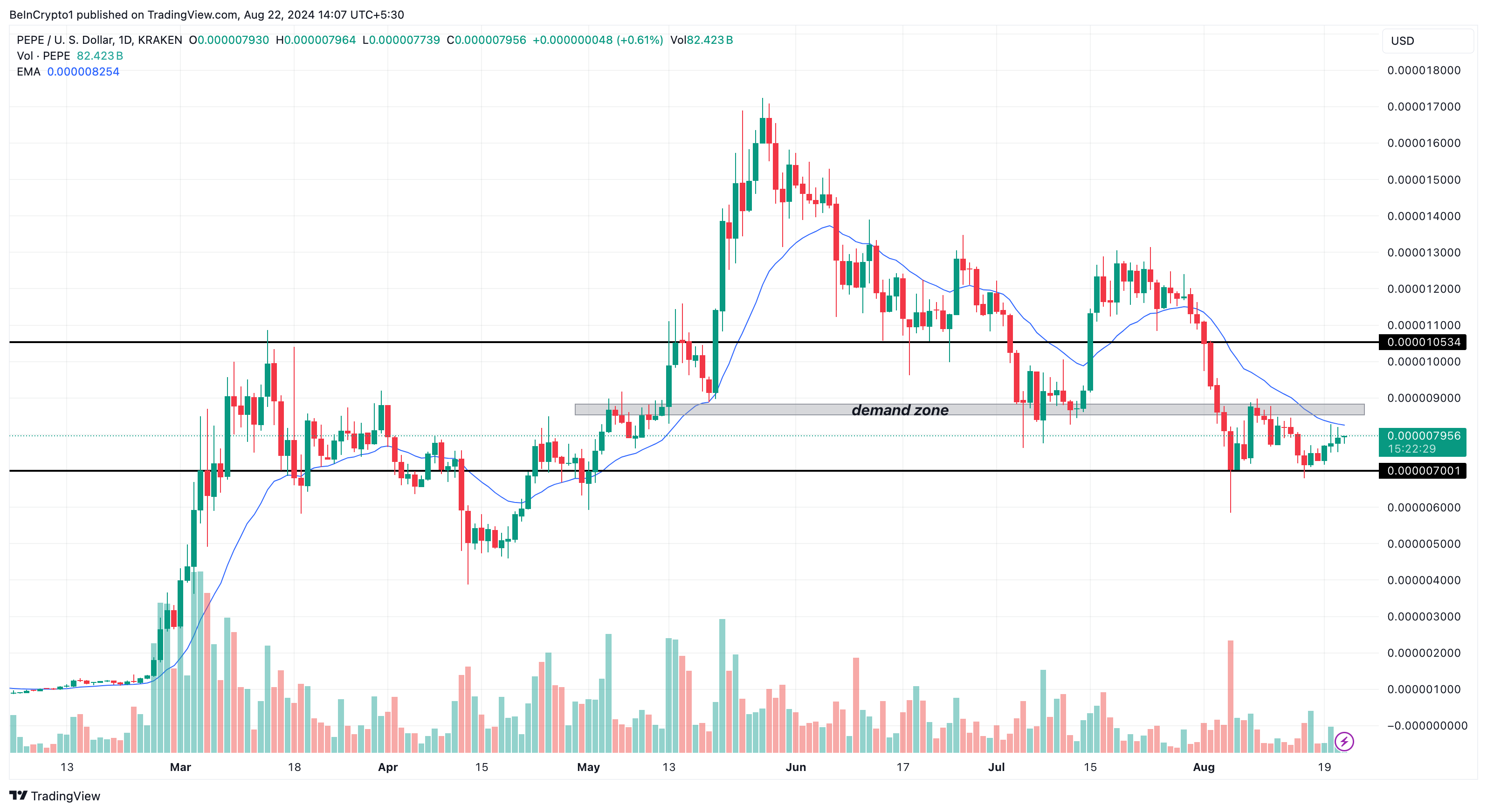
In addition, there is ongoing speculation that Coinbase might list the meme coin, fueled by the exchange’s creation of a dedicated page on its website. If this listing materializes, it could trigger a significant rally for PEPE, potentially pushing its price back to $0.000010 or higher.
Disclaimer
In line with the Trust Project guidelines, this price analysis article is for informational purposes only and should not be considered financial or investment advice. BeInCrypto is committed to accurate, unbiased reporting, but market conditions are subject to change without notice. Always conduct your own research and consult with a professional before making any financial decisions. Please note that our Terms and Conditions, Privacy Policy, and Disclaimers have been updated.
Market
Ethereum Price Recovery Stalls—Bears Keep Price Below $2K

Reason to trust

Strict editorial policy that focuses on accuracy, relevance, and impartiality
Created by industry experts and meticulously reviewed
The highest standards in reporting and publishing
Strict editorial policy that focuses on accuracy, relevance, and impartiality
Morbi pretium leo et nisl aliquam mollis. Quisque arcu lorem, ultricies quis pellentesque nec, ullamcorper eu odio.
Ethereum price attempted a recovery wave above the $1,880 level but failed. ETH is now trimming all gains and remains below the $1,880 resistance zone.
- Ethereum failed to stay above the $1,850 and $1,880 levels.
- The price is trading below $1,850 and the 100-hourly Simple Moving Average.
- There was a break below a key bullish trend line with support at $1,865 on the hourly chart of ETH/USD (data feed via Kraken).
- The pair must clear the $1,865 and $1,890 resistance levels to start a decent increase.
Ethereum Price Fails Again
Ethereum price managed to stay above the $1,800 support zone and started a recovery wave, like Bitcoin. ETH was able to climb above the $1,850 and $1,880 resistance levels.
The bulls even pushed the price above the $1,920 resistance zone. However, the bears are active near the $1,950 zone. A high was formed at $1,955 and the price trimmed most gains. There was a break below a key bullish trend line with support at $1,865 on the hourly chart of ETH/USD.
A low was formed at $1,781 and the price is now consolidating near the 23.6% Fib retracement level of the downward move from the $1,955 swing high to the $1,781 low.
Ethereum price is now trading below $1,850 and the 100-hourly Simple Moving Average. On the upside, the price seems to be facing hurdles near the $1,850 level. The next key resistance is near the $1,865 level and the 50% Fib retracement level of the downward move from the $1,955 swing high to the $1,781 low.
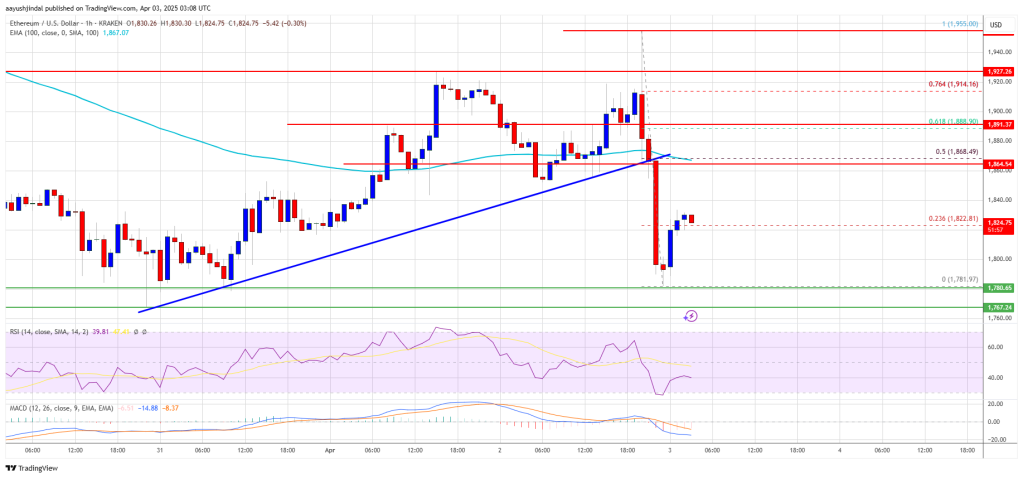
The first major resistance is near the $1,920 level. A clear move above the $1,920 resistance might send the price toward the $1,950 resistance. An upside break above the $1,950 resistance might call for more gains in the coming sessions. In the stated case, Ether could rise toward the $2,000 resistance zone or even $2,050 in the near term.
Another Decline In ETH?
If Ethereum fails to clear the $1,865 resistance, it could start another decline. Initial support on the downside is near the $1,800 level. The first major support sits near the $1,780 zone.
A clear move below the $1,780 support might push the price toward the $1,720 support. Any more losses might send the price toward the $1,680 support level in the near term. The next key support sits at $1,620.
Technical Indicators
Hourly MACD – The MACD for ETH/USD is gaining momentum in the bearish zone.
Hourly RSI – The RSI for ETH/USD is now below the 50 zone.
Major Support Level – $1,780
Major Resistance Level – $1,865
Market
Cardano (ADA) Downtrend Deepens—Is a Rebound Possible?

Cardano price started a recovery wave above the $0.680 zone but failed. ADA is consolidating near $0.650 and remains at risk of more losses.
- ADA price failed to recover above the $0.70 resistance zone.
- The price is trading below $0.680 and the 100-hourly simple moving average.
- There was a break below a connecting bullish trend line with support at $0.6720 on the hourly chart of the ADA/USD pair (data source from Kraken).
- The pair could start another increase if it clears the $0.70 resistance zone.
Cardano Price Dips Again
In the past few days, Cardano saw a recovery wave from the $0.6350 zone, like Bitcoin and Ethereum. ADA was able to climb above the $0.680 and $0.6880 resistance levels.
However, the bears were active above the $0.70 zone. A high was formed at $0.7090 and the price corrected most gains. There was a move below the $0.650 level. Besides, there was a break below a connecting bullish trend line with support at $0.6720 on the hourly chart of the ADA/USD pair.
A low was formed at $0.6356 and the price is now consolidating losses near the 23.6% Fib retracement level of the recent decline from the $0.7090 swing high to the $0.6356 low. Cardano price is now trading below $0.680 and the 100-hourly simple moving average.
On the upside, the price might face resistance near the $0.6720 zone or the 50% Fib retracement level of the recent decline from the $0.7090 swing high to the $0.6356 low. The first resistance is near $0.6950. The next key resistance might be $0.700.
If there is a close above the $0.70 resistance, the price could start a strong rally. In the stated case, the price could rise toward the $0.7420 region. Any more gains might call for a move toward $0.7650 in the near term.
Another Drop in ADA?
If Cardano’s price fails to climb above the $0.6720 resistance level, it could start another decline. Immediate support on the downside is near the $0.6420 level.
The next major support is near the $0.6350 level. A downside break below the $0.6350 level could open the doors for a test of $0.620. The next major support is near the $0.60 level where the bulls might emerge.
Technical Indicators
Hourly MACD – The MACD for ADA/USD is losing momentum in the bearish zone.
Hourly RSI (Relative Strength Index) – The RSI for ADA/USD is now below the 50 level.
Major Support Levels – $0.6420 and $0.6350.
Major Resistance Levels – $0.6720 and $0.7000.
Market
XRP Price Under Pressure—New Lows Signal More Trouble Ahead

Aayush Jindal, a luminary in the world of financial markets, whose expertise spans over 15 illustrious years in the realms of Forex and cryptocurrency trading. Renowned for his unparalleled proficiency in providing technical analysis, Aayush is a trusted advisor and senior market expert to investors worldwide, guiding them through the intricate landscapes of modern finance with his keen insights and astute chart analysis.
From a young age, Aayush exhibited a natural aptitude for deciphering complex systems and unraveling patterns. Fueled by an insatiable curiosity for understanding market dynamics, he embarked on a journey that would lead him to become one of the foremost authorities in the fields of Forex and crypto trading. With a meticulous eye for detail and an unwavering commitment to excellence, Aayush honed his craft over the years, mastering the art of technical analysis and chart interpretation.
As a software engineer, Aayush harnesses the power of technology to optimize trading strategies and develop innovative solutions for navigating the volatile waters of financial markets. His background in software engineering has equipped him with a unique skill set, enabling him to leverage cutting-edge tools and algorithms to gain a competitive edge in an ever-evolving landscape.
In addition to his roles in finance and technology, Aayush serves as the director of a prestigious IT company, where he spearheads initiatives aimed at driving digital innovation and transformation. Under his visionary leadership, the company has flourished, cementing its position as a leader in the tech industry and paving the way for groundbreaking advancements in software development and IT solutions.
Despite his demanding professional commitments, Aayush is a firm believer in the importance of work-life balance. An avid traveler and adventurer, he finds solace in exploring new destinations, immersing himself in different cultures, and forging lasting memories along the way. Whether he’s trekking through the Himalayas, diving in the azure waters of the Maldives, or experiencing the vibrant energy of bustling metropolises, Aayush embraces every opportunity to broaden his horizons and create unforgettable experiences.
Aayush’s journey to success is marked by a relentless pursuit of excellence and a steadfast commitment to continuous learning and growth. His academic achievements are a testament to his dedication and passion for excellence, having completed his software engineering with honors and excelling in every department.
At his core, Aayush is driven by a profound passion for analyzing markets and uncovering profitable opportunities amidst volatility. Whether he’s poring over price charts, identifying key support and resistance levels, or providing insightful analysis to his clients and followers, Aayush’s unwavering dedication to his craft sets him apart as a true industry leader and a beacon of inspiration to aspiring traders around the globe.
In a world where uncertainty reigns supreme, Aayush Jindal stands as a guiding light, illuminating the path to financial success with his unparalleled expertise, unwavering integrity, and boundless enthusiasm for the markets.
-

 Market23 hours ago
Market23 hours agoBNB Price Faces More Downside—Can Bulls Step In?
-

 Regulation18 hours ago
Regulation18 hours agoKraken Obtains Restricted Dealer Registration in Canada
-

 Market24 hours ago
Market24 hours agoVanEck Sets Stage for BNB ETF with Official Trust Filing
-

 Bitcoin23 hours ago
Bitcoin23 hours agoTokenized Gold Market Cap Tops $1.2 Billion as Gold Prices Surge
-

 Bitcoin19 hours ago
Bitcoin19 hours agoLummis Confirms Treasury Probes Direct Buys
-

 Altcoin14 hours ago
Altcoin14 hours agoHere’s Why This Analyst Believes XRP Price Could Surge 44x
-

 Altcoin13 hours ago
Altcoin13 hours agoHow Will Elon Musk Leaving DOGE Impact Dogecoin Price?
-

 Altcoin9 hours ago
Altcoin9 hours agoFirst Digital Trust Denies Justin Sun’s Allegations, Claims Full Solvency














